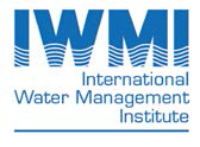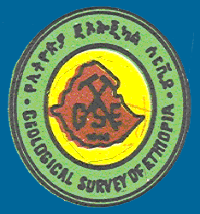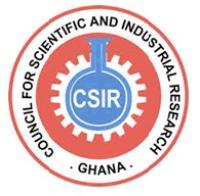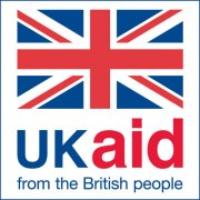South Africa
1. Background
Consultations and preliminary investigations have identified a suitable study site for AMGRAF research in South Africa in Limpopo Province. This is South Africa’s northern-most province (Figure 1) which shares borders with Mozambique, Zimbabwe and Botswana. About 89% of the population lives in rural areas and over 88% of the area of the province is farmland. The pilot site in South Africa is located inthe Grater Giyani Local Municipality of the Limpopo Province. The Giyani area was earmarked for development by the national Comprehensive Rural Development Programme aimed at fostering business enterprises, land reform and agrarian transformation.
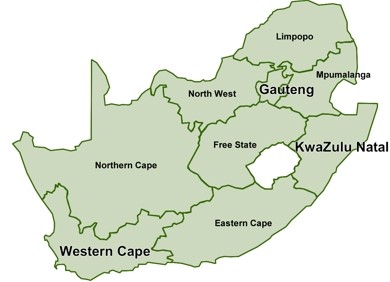
Figure 1: Provinces of South Africa showing location of study site
In order to enhance rural development, the South African government established over the years a number of irrigation schemes in Limpopo Province. However, over-utilization of water upstream and droughts caused water shortages and irrigation schemes to be put out of operation in favour of water supply to the population since 2007. Emerging farmers therefore turned to alternative water supply sources, mainly pumping from adjacent streams and groundwater.
Past research work on irrigation schemes for small-scale farmers, indicated that farmers need to be involved and participate from the outset of the research process in order to facilitate the uptake of technologies. The irrigation farming enterprises need to consider the bio-physical and chemical aspects of increasing crop production, the socio-economic aspects that sustain livelihood, and the environmental aspects that ensure sustainable utilization of soil and water. In order to provide food security by increasing sustainable productivity, some definite needs that were mentioned in past research are crop diversification, in particular the introduction of alternative cash crops, and mechanisms for market access.
2. Description of the environment
The study area is located in summer rainfall sub-tropical climate. Rainfall (between 500 and 600 mm) occurs in a single rainy season running from October to March. The average temperature is 25.5 °C. The average potential mean annual gross evaporation (as measured by A-pan) is about 1,700 mm. The study area is at the interface between the granitic-greenstone of the KaapVaal Craton and the metamorphic (predominantly gneiss rocks, but also schist) of the Southern Marginal zone of the Limpopo Mobile Belt. The topography is gently undulated and the dominant soils are red, massive or weakly structured, with high base status (association of well drained Lixisols, Cambisols, Luvisols). Dominant land cover in the area is agricultural, grassland and indigenous mopani bush forest.
The South African Department of Water and Environmental Affairs classified the water resources into 19 Water Management Areas (WMA). The study site lies in the northern-most WMA, namely the Luvuvhu/Letaba (WMA No. 2). The Levhuvu/Letaba WMA is divided into three primary catchments, namely Levhuvu, Shingwedzi and Letaba. The town of Giyani is in the vicinity of the Middle Letaba and Nsami dams in its vicinity. The largest user of the available water resources in the WMA is irrigation, while other significant users include forestry and rural domestic water use, international requirements and transfers out of the WMA. In the Luvuvhu/Letaba WMA, irrigation accounted for nearly 75% of the total water requirements in the WMA (in 2003). Mean annual runoff depends strongly on rainfall and land use. Deep fractured aquifers occur in the high-lying areas at the base of the escarpment, where the weathered layer is thin or absent bare leucogranites are often exposed. Alluvial deposits can be found along the main rivers, where intergranular aquifers occur overlying weathered material. Time series of climate, hydrological and groundwater data are submitted together with this report, as well as soil, geology and land cover maps for the Letaba catchment. These data can be used for setting up and calibrating hydrological models.
3. Agricultural production
Agriculture is a key economic sector in the LimpopoProvince. There are two distinct agricultural production systems in the province, small-holder agriculture and large scale commercial farming. Large scale commercial agriculture is characterized by large farms, it is mainly situated on prime agricultural land, it occupies about 70% of the agricultural area and it utilizes advanced production technologies. Small-holder agriculture is located mostly in the former homeland areas and covers about 30% of the provincial land surface area. Small-holder agriculture is characterized by a low level of production technology and small land holdings of approximately 1.5 ha per farm. The small-holder sector production is primarily for subsistence with small surpluses which are marketed. Although irrigated agriculture is of great importance to the LimpopoProvince, shortages of water impact on the sector.
Agriculture is a key economic activity in Greater Giyani Municipality and small scale agriculture, centred around maize, vegetables, tomatoes and rearing of beef cattle, is a key component. The EAU4Food project site is located in a small-holder farming area. Farmers at the site grow tomatoes, green pepper, spinach, cabbage, beetroot, carrots, maize, butternuts, okra, watermelon, mangoes, baby marrows, chillies, lettuce and onion under irrigation using water from the Greater Letaba River, its tributaries or groundwater. Over 70% of the land in Giyani is in the low-moderate land capability class. It was estimated that 59.4% of the total area of the Greater Giyani Municipality consisted of cultivated areas and 30% was covered by woodland and bushland. The town of Giyani accounted for 0.7% of the total area, while 5.4% was taken up by villages. The degraded areas accounted for approximately 5.0%.
The soils are mainly deep, well-drained Oxisols with clay content usually < 30%. Irrigation water qualities are generally within the range suitable for agricultural use with variable pH, ionic speciation and occasionally elevated NO3 (above levels recommended for human or cattle consumption), possibly due to the vicinity of populated areas. Agricultural land in the Greater Giyani Municipality is predominantly Government land and it is administered by chiefs. Many farms are under the Permission to Occupy (PTO) system of land tenure.
4. Socio-economic characteristics
The population in the Luvuvhu/Letaba WMA is about 1,535,000 people (1995 population, which is about 3.5% of the country’s total), whilst the population in Greater Giyani Municipality is about 247,600. More than 90% of the population was rural-based, with most living in informal rural villages and settlements. The population was relatively evenly distributed throughout the region. The Luvuvhu/Letaba WMA contributed less than 1% of the Gross Domestic Product (GDP) of South Africa in 1997. The largest economic sectors were government and mining, followed by agriculture. Irrigated agriculture makes a significant contribution to the economy of the WMA and is a major user of water. Most of the rainfed cultivation and cattle herding are practised as subsistence farming on communal lands.
The workforce in the WMA was estimated at 343,000 in 1994, 41% of which were employed in the formal economy and 49% were unemployed. Amongst the formally employed workforce, 53% were in the government sector, whilst 19% were in agriculture and 9% in trade.
Available information on socio-economic indicators is largely based on the 2001 national census and household surveys conducted shortly thereafter. In 2003, the Human Development Index (HDI) of the LimpopoProvince was 0.59, the lowest in South Africa, against South Africa’s HDI of 0.67 at the time. Limpopo is the second poorest Province in South Africa. Approximately 77% of the population lived below the poverty income line in 2001. South Africa’s Rural Water Livelihood Index (RWLI) for 2008 was 70.37. RWLI figures are not available for the provincial or municipal level. Although no figures are available for the Water Poverty Index (WPI) for the study site, in the neighbouring OlifantsBasin, the WPI was reported to be 27.1 in 2001, while the national WPI for that period was estimated at 52.2.
Small-scale farmers have historically been excluded from markets in South Africa. The dominance of large-scale farmers in the South African agricultural commercial sector and the development of centralized procurement and preferred suppliers’ schemes by buyers of fresh produce such as supermarkets are some of the factors that contributed strongly to the exclusion of small-scale farmers. However, with political and social changes in the country, as well as the spreading of supermarkets in rural areas, there are new and innovative strategies towards including small-scale farmers into supermarket procurement systems. From the preliminary interaction with farmers during farm visits conducted in November 2011, it was established that farmers who practise irrigation at the study site market their crops through both formal and informal chains. Markets include surrounding villages, local supermarkets such as Spar and Boxer and the national fresh produce market for produce such as tomatoes and onions. Produce is also sold to hawkers and vendors from Giyani.
The current infrastructure in Giyani is inadequate to supply water to the whole of Greater Giyani Municipality. Most (54.9% in 2001) of the residents of Giyani have no sanitation facilities while just over one fifth (22.5% in 2001) use pit latrines without ventilation. The provision of services is difficult as most of the settlements in the Municipal area are in the form of dispersed villages. The road conditions are bad and this has implications to the economic activity in the municipality.
5. Institutional organizations
South Africa has a three-tier system of Government consisting of national, provincial and local Government. Greater GiyaniMunicipality is one of 5 Municipalities in the Mopani District of the LimpopoProvince. The District and local Municipalities have a key role in the management of water resources and this has implications to irrigated agriculture.
The legal instrument that guides water resources management in South Africa is the National Water Act (NWA; Act No. 36 of 1998). The Department of Water Affairs is responsible for water resource management. In terms of water allocation, the NWA gives priority to the reserve (including both water for basic human needs and for the natural environment), thereafter international agreements must be honoured while additional allocations should be prioritised according to the social and economic benefits that will be achieved by these allocations. The NWA makes provision for the establishment of Catchment Management Agencies (CMA), and there is one CMA in each of the 19 Water Management Areas in South Africa. The CMAs are responsible for managing water resources at catchment level in cooperation with local stakeholders. Other institutions of relevance to water management are Catchment Management Fora, the Middle Letaba Water Users Association, Irrigation and Water Boards, Municipalities and the Regional Office of the Department of Water Affairs (in lieu of the CMA). The roles and interactions between various water management institutions are discussed in the appended detailed report.
Main agricultural institutions in the LimpopoProvince include Agri Limpopo, TAU SA, National African Farmers Union (NAFU), Northern Region Agricultural Farmers Union (NORAFU) and Sub-tropical Growers Association.

